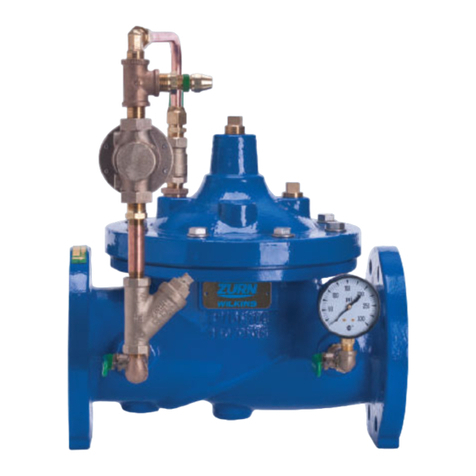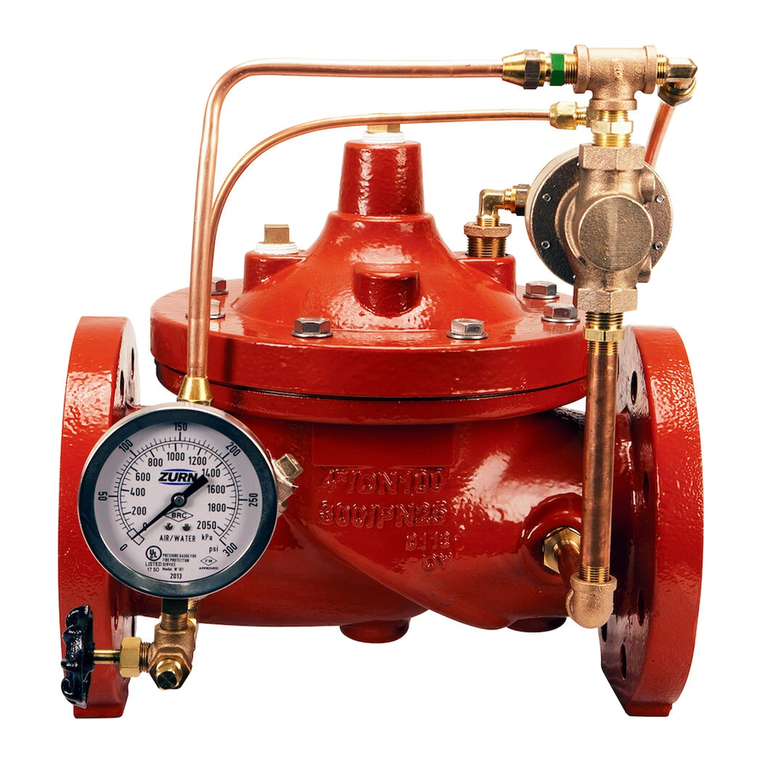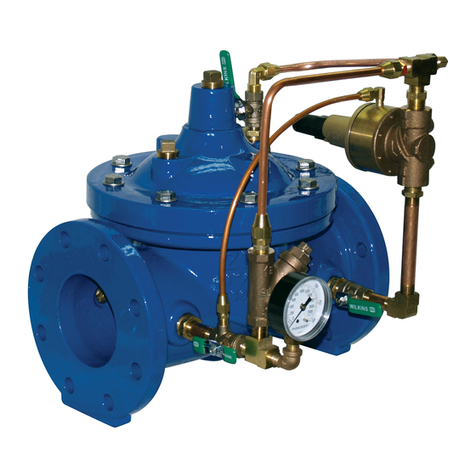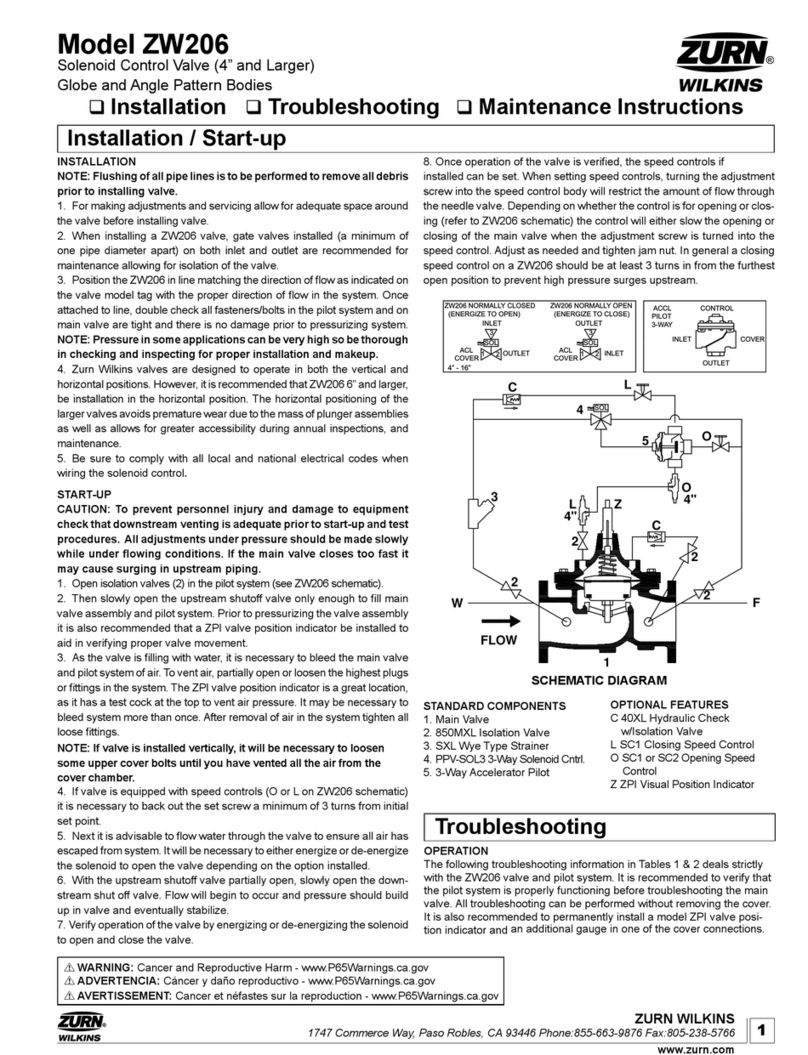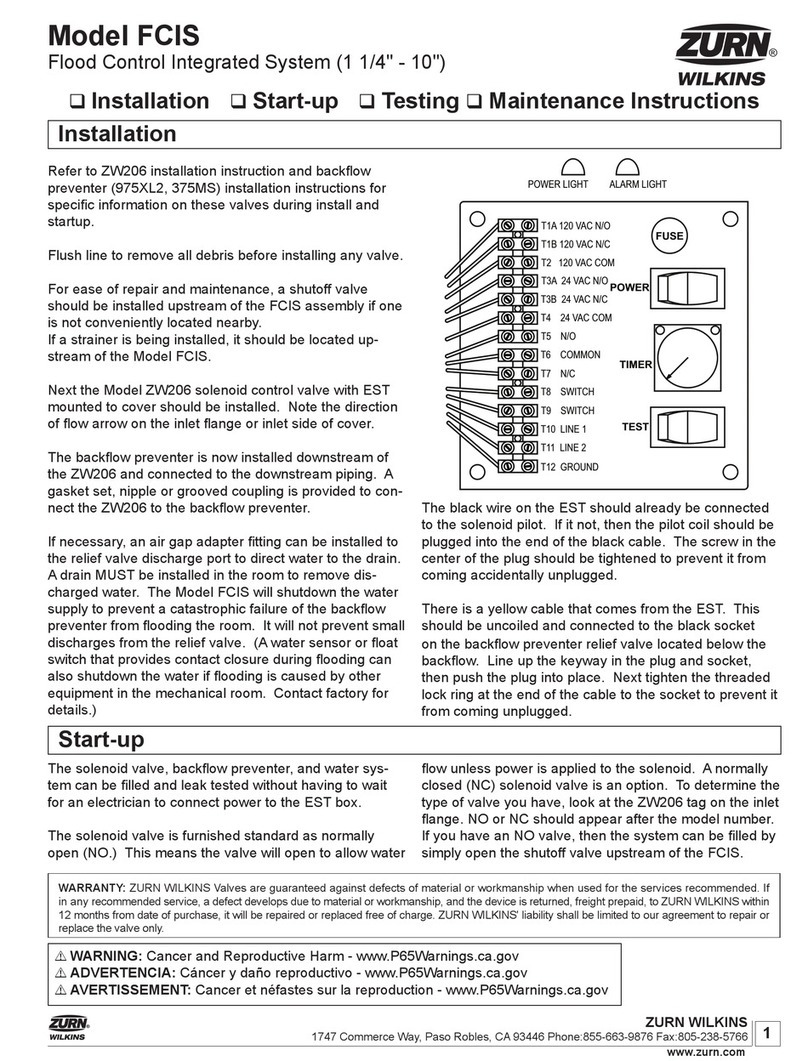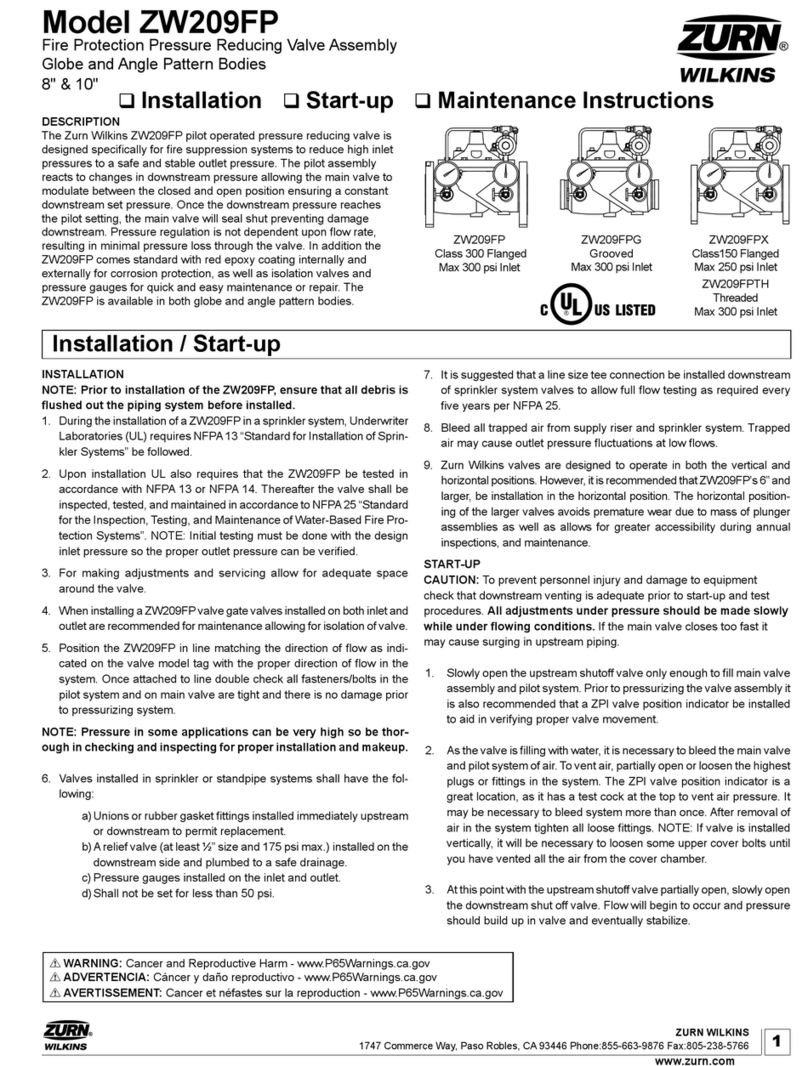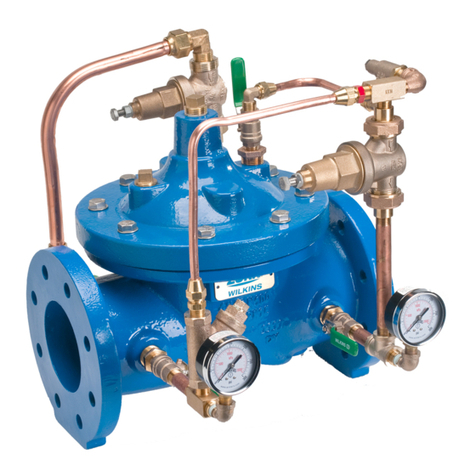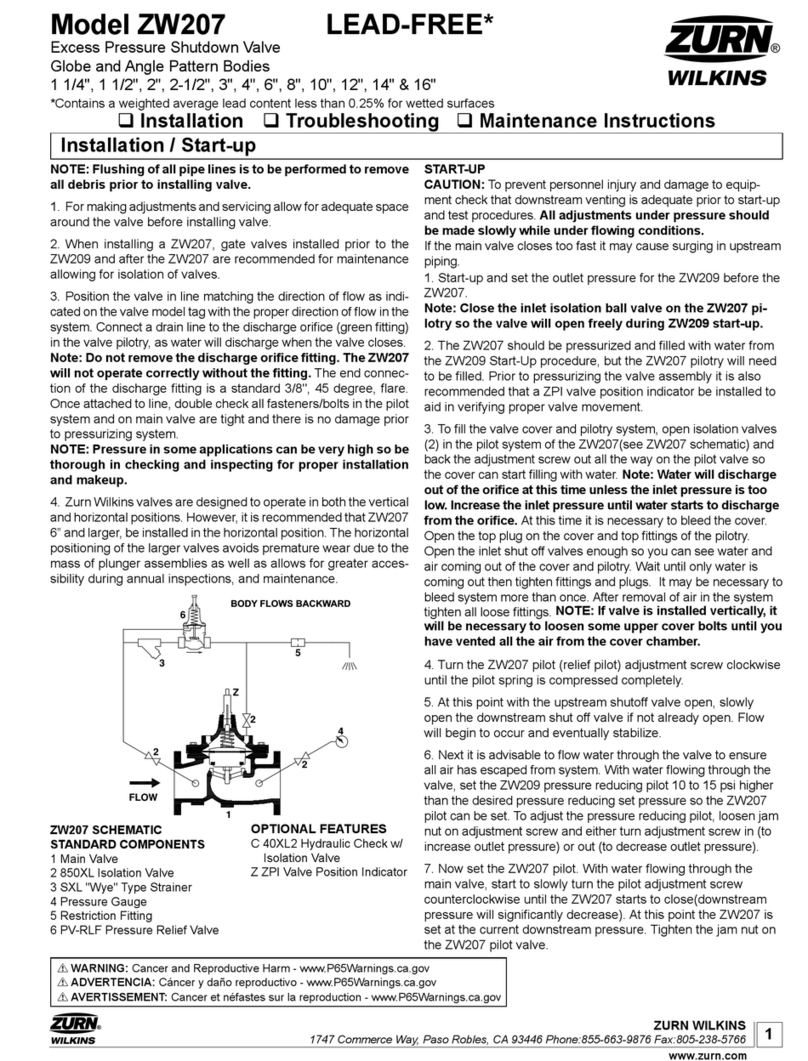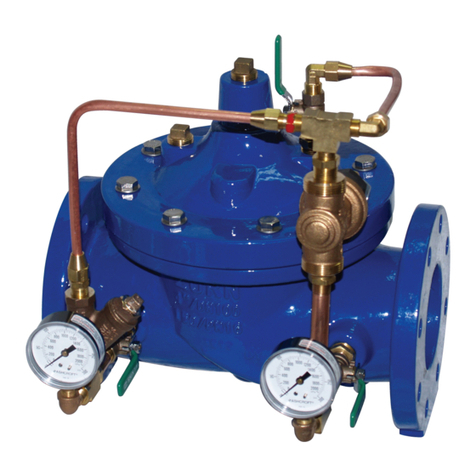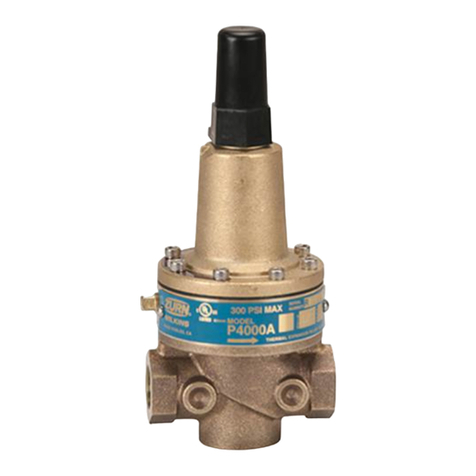
Troubleshooting
PILOT SYSTEM FUNCTION CHECK
CAUTION: To prevent personnel injury and damage to
equipment check that downstream venting is adequate
prior to start-up and test procedures.
PRESSURE SUSTAINING PILOT CHECK
1. With pressure on the inlet of the ZW209H turn the pressure
sustaining pilot (PV-RLF) adjustment screw clockwise all the
wayin.
2.Closetheoutletisolationballvalve.Opendownstreamtting
orconnectionsowatercanowthroughvalve.Valveshould
closeaftersometime.Ifinstalled,verifythevalvepositionindi-
cator (model ZPI) is closed.
3.Ifthereiscontinuousow,themainvalveisnotsealingprop-
erly.Itisrecommendedthatthemainvalvebedisassembled
andinspected(Referto“Disassembly”section).
4.Opentheoutletisolationballvalve.Theinletpressuremust
be less than the maximum adjustment of the relief pilot (PV-
RLF)shownontag.Iftherewasnoowduringtheprevious
step,butthereisnowcontinuousow,thereliefpilotvalveis
notsealingproperly.Itisrecommendedthatthepilotvalvebe
disassembled and inspected.
5. Relieve downstream pressure then turn the adjustment
screw on the relief pilot counterclockwise until water starts to
ow.Ifnowaterstartstoowandthereisinletpressure,then
thepilotisnotfunctioningcorrectly.Itisrecommendedthatthe
pilot valve be disassembled and inspected.
PRESSURE PILOT REDUCING CHECK
1. With pressure on the inlet of the ZW209H turn the relief pilot
(PV-RLF) adjustment screw counterclockwise until the screw
startstospinfreelytolowerthereliefpressuresetpoint.Inlet
pressure must be above 10 psi.
2.Slowlyclosetheoutletballvalveinthepilotsystem.Open
downstreamttingorconnectiontoallowwaterow.Allowthe
cover to pressurize and the main valve to close. If installed,
verifythevalvepositionindicator(modelZPI)isinaclosed
position.
3. Close the cover ball valve to keep the main valve closed.
4.Proceedwithventingoutletdownstreampressurebyopening
a source downstream. When opening the downstream source if
thereiscontinuousow,themainvalveisnotsealingproperly.
It is recommended that the main valve be disassembled and
inspected(Referto“Disassembly”section).
5. With the main valve closed, open outlet isolation valve and
allowasmallamountofwatertoowthroughthevalvepilotby
cracking open a downstream source. There should be continu-
ousow.Ifnot,thepressurereducingpilotvalveisnotopen-
ingproperly.Itisrecommendedthatthepilotvalvebedisas-
sembled and inspected (Refer to appropriate pressure reducing
pilot valve instruction sheet).
6. Monitor outlet pressure while cracking open and closing the
downstreamshutoffvalveandcomparetothedesiredsystem
settings. If the outlet pressure is the same as the inlet pressure
orclimbsmorethan15psiabovetheowingreducedpressure
setpoint,thepressurereducingpilotisnotproperlyregulating
(refertothepilottroubleshootingPressureReducingPilotSys-
tem Troubleshooting, Table 2. Corrective Action section).
7.Ifthepressureisregulatingtothedesiredsystempressures
proceed with diagnosis checks for the main valve.
DIAGNOSIS CHECKS
CAUTION: Do not service valve while under pressure. When
performing diagnosis checks on the ZW209H when the valve
is fully open, high ow rates and high downstream pres-
sures can occur.
DIAPHRAGM CHECK
1.Slowlycloseupstreamshutoffvalveandrelieveallpressure
downstream.
2. With all pressure relieved in the main valve, close both inlet
and outlet isolation valves and remove side plug on cover and
leave off.
3.Thenopenupstreamshutoffvalvepartially,allowingwater
toowthroughthevalve.Whileowingwatermonitortheopen-
ingonthecover.Ifuidbeginstoowoutoftheopenholein
thecover,thenthereismostlikelydamagetothediaphragm
oruidisleakingpastthediaphragmassemblyduetoloose
assembly.Itisrecommendedthatthevalvecoverberemoved
to investigate the leakage (To remove cover see “Maintenance”
sectionforprocedures).Ifnowaterowsoutofcoverthenthe
diaphragmisgoodandyoumayproceedtothediaphragm
movement check.
DIAPHRAGM MOVEMENT CHECK
1. The diaphragm movement check can be determined during
the diaphragm check or it can also be performed with the use of
a valve position indicator model ZPI.
2. Replace cover plug and open pilot ball valves on inlet and cover.
3.Closingtheoutletisolationballvalveswilldirecttheowto
the cover causing it to close. NOTE: Slow or delayed closing
of main valve is normal and is due to the time requirements
to ll, pressurize cover, and stretch the diaphragm into the
closed position. This normal delay is not mechanical bind-
ing of the valve assembly.
4. Using the valve position indicator, make note of the closed
position on the indicator. Compare distance of the open mark to
the close mark and compare to Table 3.
5.Verifythatthemainvalveisclosed,byopeningadown-
stream source (not the outlet isolation ball valve on the main
body).Ifwatercontinuouslyows,thenthemainvalveisnot
sealingproperly.Doublecheckthevalvemovementmatches
thevaluesinTable3andrefertothedisassemblyprocedures
section if it does not. This is an indication that the main valve is
not sealing due to an obstruction between the seat and the seal
oradamagedseal.Ifwaterdoesstopowingandthemeasured
valve movement does not match Table 3, then there is possible
damageunderthecover.Removecovertoidentifyobstruction
andreplacepartsasnecessary.
TABLE 3. VALVE STEM TRAVEL
3
ZURN WILKINS
1747 Commerce Way, Paso Robles, CA 93446 Phone:855-663-9876 Fax:805-238-5766
www.zurn.com
VALVE SIZE
(in)
VALVE SIZE
(mm)
STEM TRAVEL
(in)
STEM TRAVEL
(mm)
1-1/4" - 1-1/2" 38 0.4 10.2
2" 50 0.7 18.0
2-1/2" 65 0.8 21.3
3" 80 0.9 23.4
4" 100 1.1 28.8
6" 150 1.7 43.4
8" 200 2.4 59.7
10" 250 2.8 71.1
12" 300 3.4 86.4
14" 350 3.8 96.5
16" 400 4.3 109.2




